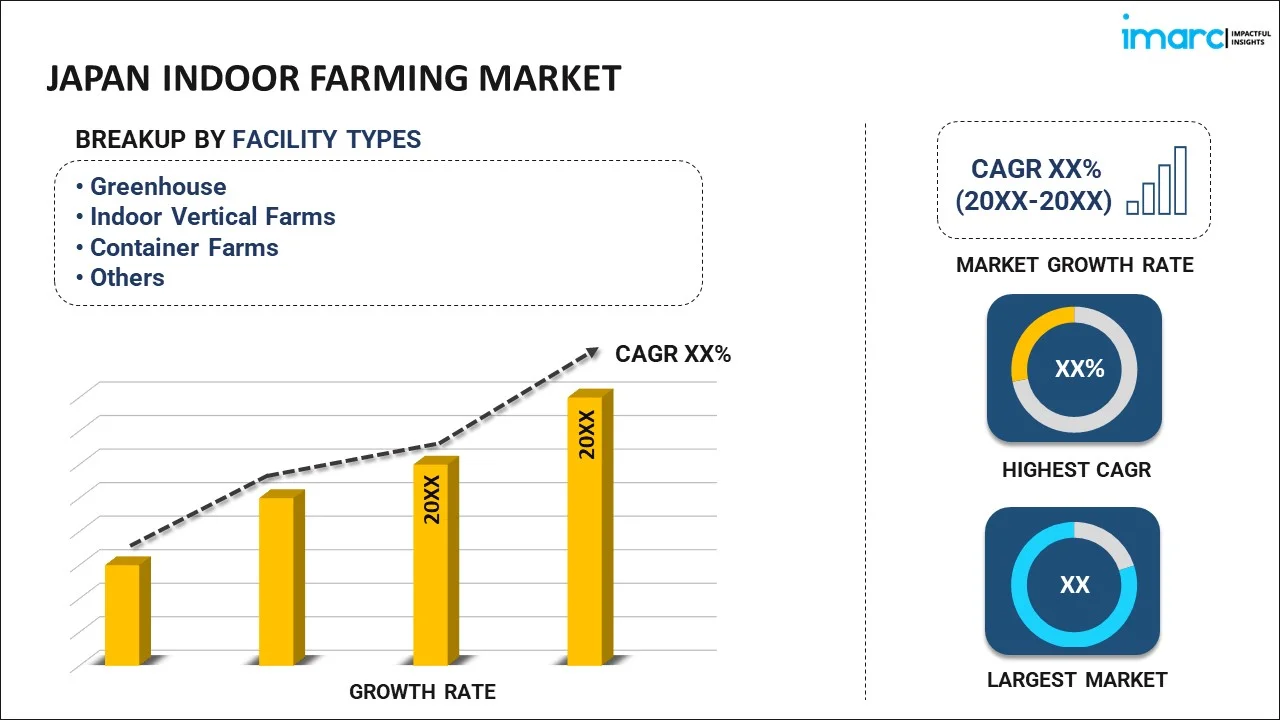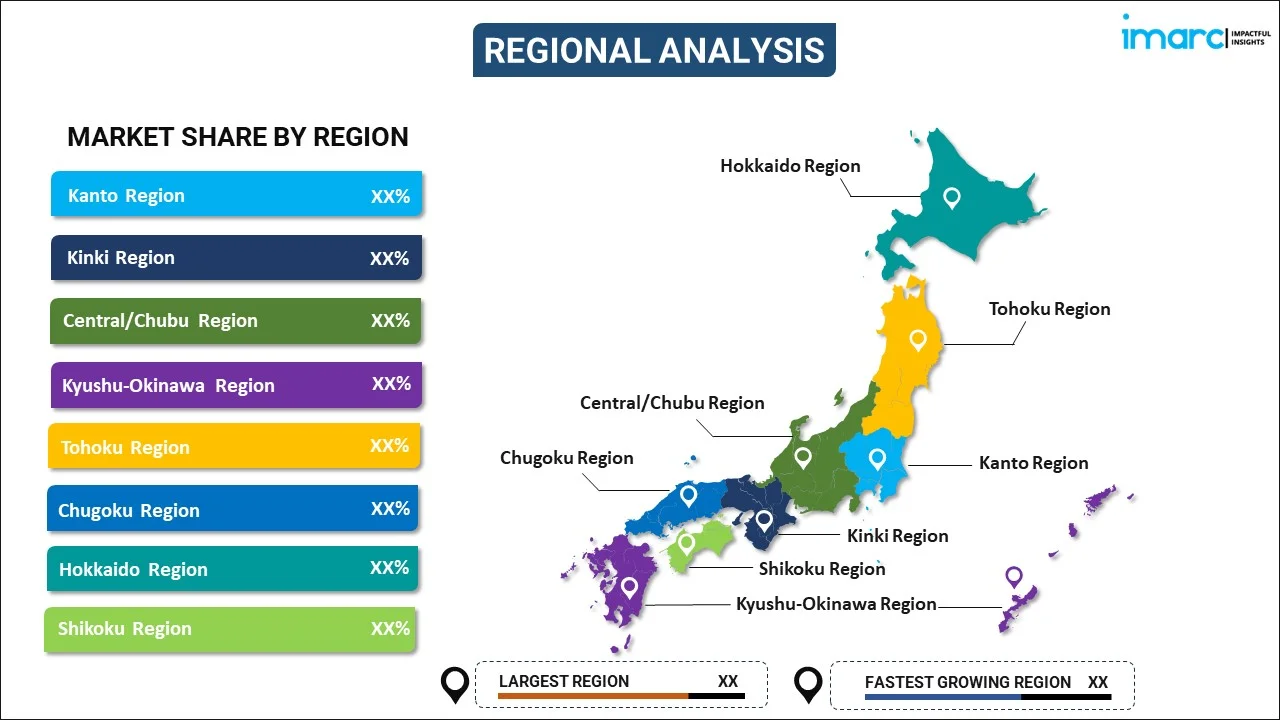
Japan Indoor Farming Market Report by Facility Type (Greenhouse, Indoor Vertical Farms, Container Farms, Indoor Deep Water Culture, and Others), Crop Type (Fruits, Vegetables, and Herbs, Flowers and Ornamentals, and Others), Component (Hardware, Software), Growing System (Aeroponics, Hydroponics, Aquaponics, Soil-based, Hybrid), and Region 2025-2033
Market Overview:
The Japan indoor farming market size reached USD 1,336.7 Million in 2024. Looking forward, IMARC Group expects the market to reach USD 2,951.6 Million by 2033, exhibiting a growth rate (CAGR) of 9.2% during 2025-2033. The limited availability of fertile land, harsh weather conditions that make traditional farming challenging, and rising interest in sustainability to promote environmental health represent some of the key factors driving the market.
|
Report Attribute
|
Key Statistics
|
|---|---|
|
Base Year
|
2024 |
|
Forecast Years
|
2025-2033
|
|
Historical Years
|
2019-2024
|
| Market Size in 2024 | USD 1,336.7 Million |
| Market Forecast in 2033 | USD 2,951.6 Million |
| Market Growth Rate (2025-2033) | 9.2% |
Indoor farming, also known as controlled environment agriculture, refers to the practice of cultivating plants within an enclosed setting, such as a greenhouse, and a completely closed environment like a warehouse. It relies on vertical farming structures, which enables growers to cultivate plants in stacks and make most of the available space. It allows for the year-round growth of plants, independent of external weather conditions, by controlling factors like light, temperature, humidity, and nutrient levels. It requires significantly less water than traditional soil-based farming as the water in these systems is recirculated. It helps eliminate the need for pesticides as it provides a controlled environment that can be kept free of pests and diseases. It enables the cultivation of fresh produce in urban areas, reduces transportation distances and improves access to fresh food. Moreover, it provides an ideal platform for plant research and allows scientists to control and manipulate the growing environment to better understand plant growth and development.
Japan Indoor Farming Market Trends:
Indoor farming in Japan is currently experiencing growth, largely driven by a combination of societal, technological, and environmental factors. The increasing aging population of the country is gradually leading to a decrease in the workforce involved in traditional farming. This is promoting the adoption of less labor-intensive farming methods, such as indoor farming. Additionally, a large population of Japan is residing on a relatively smaller land area, much of which is mountainous and arable land. As a result, vertical farming, a type of indoor farming, is gaining popularity due to its ability to maximize crop yield per square meter, making efficient use of available space. Moreover, the country is frequently exposed to harsh weather conditions, such as typhoons and heavy rainfall, which devastates outdoor crops. This, in turn, is increasing the need for indoor farming as a more reliable and resilient method of food production. Additionally, advancements in technologies, such as light-emitting diode (LED) lighting, automation, and artificial intelligence are enhancing the efficiency and productivity of indoor farms in Japan. Besides this, innovations in hydroponics, aeroponics, and aquaponics systems are also driving the market in the country.
Key Market Segmentation:
IMARC Group provides an analysis of the key trends in each segment of the Japan indoor farming market report, along with forecasts from 2025-2033. Our report has categorized the market based on facility type, crop type, component, and growing system.
Facility Type Insights:

- Greenhouse
- Indoor Vertical Farms
- Container Farms
- Indoor Deep Water Culture
- Others
The report has provided a detailed breakup and analysis of the Japan indoor farming market based on the facility type. This includes greenhouse, indoor vertical farms, container farms, indoor deep water culture, and others.
Crop Type Insights:
- Fruits, Vegetables, and Herbs
- Lettuce
- Spinach
- Kale
- Tomato
- Herbs
- Bell and Chilli Peppers
- Strawberry
- Cucumber
- Others
- Flowers and Ornamentals
- Annuals
- Perennials
- Ornamentals
- Others
- Others
The report has provided a detailed breakup and analysis of the Japan indoor farming market based on the crop type. This includes fruits, vegetables, and herbs (lettuce, spinach, kale, tomato, herbs, bell and chilli peppers, strawberry, cucumber, and others), flowers and ornamentals (annuals, perennials, ornamentals, and others), and others.
Component Insights:
- Hardware
- Structure
- LED Lights
- HVAC
- Climate Control Systems
- Irrigation Systems
- Others
- Software
- Web-based
- Cloud-based
The report has provided a detailed breakup and analysis of the Japan indoor farming market based on the component. This includes hardware (structure, LED lights, HVAC, climate control systems, irrigation systems, and others) and software (web-based and cloud-based).
Growing System Insights:
- Aeroponics
- Hydroponics
- Aquaponics
- Soil-based
- Hybrid
A detailed breakup and analysis of the Japan indoor farming market based on the growing system has also been provided in the report. This includes aeroponics, hydroponics, aquaponics, soil-based, and others.
Regional Insights:

- Kanto Region
- Kinki Region
- Central/Chubu Region
- Kyushu-Okinawa Region
- Tohoku Region
- Chugoku Region
- Hokkaido Region
- Shikoku Region
The report has also provided a comprehensive analysis of all the major regional markets, which include the Kanto region, Kinki region, central/Chubu region, Kyushu/Okinawa region, Tohoku region, Chugoku Region, Hokkaido region, and Shikoku region.
Competitive Landscape:
The report has also provided a comprehensive analysis of the competitive landscape in the Japan indoor farming market. Competitive analysis such as market structure, key player positioning, top winning strategies, competitive dashboard, and company evaluation quadrant has been covered in the report. Also, detailed profiles of all major companies have been provided.
Report Coverage:
| Report Features | Details |
|---|---|
| Base Year of the Analysis | 2024 |
| Historical Period | 2019-2024 |
| Forecast Period | 2025-2033 |
| Units | Million USD |
| Scope of the Report | Exploration of Historical and Forecast Trends, Industry Catalysts and Challenges, Segment-Wise Historical and Predictive Market Assessment:
|
| Facility Types Covered | Greenhouse, Indoor Vertical Farms, Container Farms, Indoor Deep Water Culture, Others |
| Crop Types Covered |
|
| Components Covered |
|
| Growing Systems Covered | Aeroponics, Hydroponics, Aquaponics, Soil-based, Hybrid |
| Regions Covered | Kanto Region, Kinki Region, Central/Chubu Region, Kyushu/Okinawa Region, Tohoku Region, Chugoku Region, Hokkaido Region, Shikoku Region. |
| Customization Scope | 10% Free Customization |
| Post-Sale Analyst Support | 10-12 Weeks |
| Delivery Format | PDF and Excel through Email (We can also provide the editable version of the report in PPT/Word format on special request) |
Key Questions Answered in This Report:
- How has the Japan indoor farming market performed so far and how will it perform in the coming years?
- What has been the impact of COVID-19 on the Japan indoor farming market?
- What is the breakup of the Japan indoor farming market on the basis of facility type?
- What is the breakup of the Japan indoor farming market on the basis of crop type?
- What is the breakup of the Japan indoor farming market on the basis of component?
- What is the breakup of the Japan indoor farming market on the basis of growing system?
- What are the various stages in the value chain of the Japan indoor farming market?
- What are the key driving factors and challenges in the Japan indoor farming market?
- What is the structure of the Japan indoor farming market and who are the key players?
- What is the degree of competition in the Japan indoor farming market?
Key Benefits for Stakeholders:
- IMARC’s report offers a comprehensive quantitative analysis of various market segments, historical and current market trends, market forecasts, and dynamics of the Japan indoor farming market from 2019-2033.
- The research study provides the latest information on the market drivers, challenges, and opportunities in the Japan indoor farming market.
- Porter's five forces analysis assist stakeholders in assessing the impact of new entrants, competitive rivalry, supplier power, buyer power, and the threat of substitution. It helps stakeholders to analyze the level of competition within the Japan indoor farming industry and its attractiveness.
- Competitive landscape allows stakeholders to understand their competitive environment and provides an insight into the current positions of key players in the market.
Need more help?
- Speak to our experienced analysts for insights on the current market scenarios.
- Include additional segments and countries to customize the report as per your requirement.
- Gain an unparalleled competitive advantage in your domain by understanding how to utilize the report and positively impacting your operations and revenue.
- For further assistance, please connect with our analysts.
 Inquire Before Buying
Inquire Before Buying
 Speak to an Analyst
Speak to an Analyst
 Request Brochure
Request Brochure
 Request Customization
Request Customization




.webp)




.webp)












